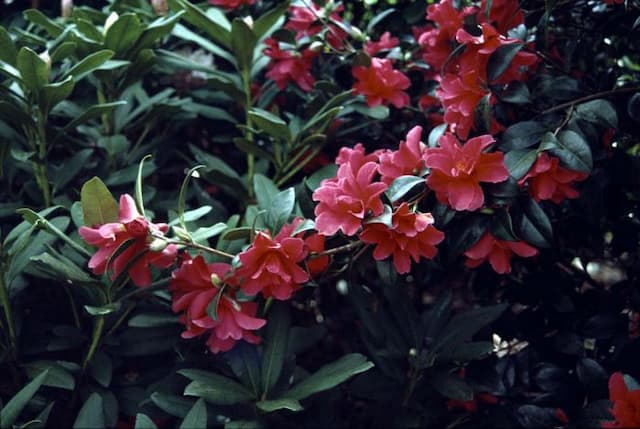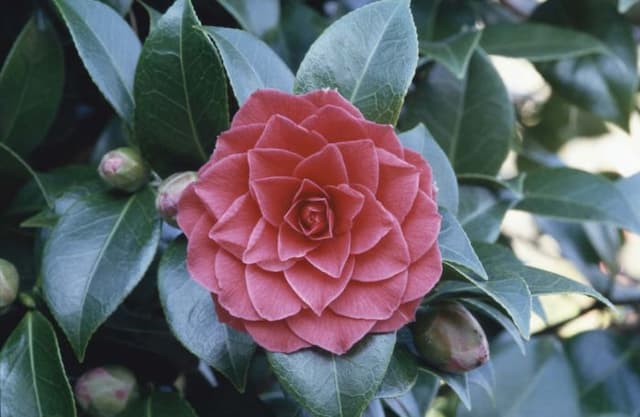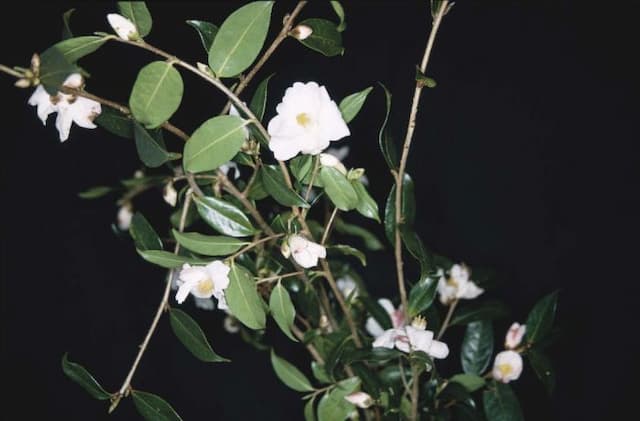Japanese Camellia Camellia japonica 'Elizabeth Hawkins'

ABOUT
Camellia japonica 'Elizabeth Hawkins' is a renowned ornamental plant celebrated for its exquisite blossoms and lustrous, evergreen foliage. The leaves are typically dark green, glossy, and oval-shaped with a leathery texture, providing a perfect backdrop for the flowers. The blooms, which are the standout feature, are large and show a delicate shade of pink, often with deeper pink stripes or flecks that add to their allure. These flowers tend to have a classic, formal double form, meaning the petals are arranged in several concentric circles around a hidden center, creating a full and luxurious appearance. The petals are robust and may have a slight ruffling at the edges, which contributes to the plant's overall grace and elegance. Depending on the stage of the bloom, the central petals can sometimes curl inward, creating a sense of depth and complexity. Camellia japonica 'Elizabeth Hawkins' typically flowers in the cooler months, bringing color and life to gardens when many other plants are dormant.
About this plant
 Names
NamesFamily
Theaceae.
Synonyms
Japanese Camellia, Common Camellia, Japonica.
Common names
Camellia japonica 'Elizabeth Hawkins'.
 Toxicity
ToxicityTo humans
Camellia japonica, commonly known as Japanese camellia, is not considered toxic to humans. There are no well-documented cases of poisoning from ingesting this plant, and it is generally regarded as safe. However, as with many plants, individual reactions can vary, and it is always prudent to avoid eating any plant parts unless they are known to be edible.
To pets
Japanese camellia is also considered non-toxic to pets. There are no significant symptoms associated with the ingestion of this plant by animals such as dogs and cats. It is not known to cause any serious consequences if pets consume parts of the plant. Nonetheless, it is always a good practice to discourage pets from eating ornamental plants to prevent any potential gastrointestinal upset.
 Characteristics
CharacteristicsLife cycle
Perennials
Foliage type
Evergreen
Color of leaves
Dark green
Flower color
Pink
Height
6-12 feet (1.8-3.7 meters)
Spread
5-10 feet (1.5-3 meters)
Plant type
Shrub
Hardiness zones
7
Native area
Japan
Benefits
 General Benefits
General Benefits- Aesthetic Appeal: The Camellia japonica 'Elizabeth Hawkins' offers beautiful, large, semi-double pink flowers that can enhance the visual appearance of gardens and landscapes.
- Seasonal Interest: It blooms during late winter to early spring, providing color and interest during a time when few other plants are in flower.
- Wildlife Attraction: Its flowers can attract pollinators like bees, contributing to the biodiversity of the area.
- Privacy Screen: When planted in groups, it can form a dense, evergreen screen that adds privacy to a yard or garden space throughout the year.
- Shade Tolerance: This plant is capable of growing in partially shaded conditions, offering flexibility in garden design and planting location.
- Drought Resistance: Once established, it can tolerate some drought, reducing the need for frequent watering during dry periods.
- Low Maintenance: Requires minimal pruning and care once established, making it an easy plant to maintain for gardeners of all skill levels.
- Longevity: Camellias are known for being long-lived, providing beauty and structure to a garden for many years.
 Medical Properties
Medical PropertiesThis plant is not used for medical purposes.
 Air-purifying Qualities
Air-purifying QualitiesThis plant is not specifically known for air purifying qualities.
 Other Uses
Other Uses- Crafting dyes: The petals of Camellia japonica can be used to create natural dyes for fabrics, offering a range of colors from pinks to red depending on the mordant used.
- Culinary garnish: The vibrant flowers of Camellia japonica can serve as an edible decoration for salads and desserts, adding a splash of color to the presentation.
- Photography subject: Due to its stunning blossoms, Camellia japonica is popular among photographers looking to capture the beauty of flowers and practicing macro photography techniques.
- Non-toxic ink: The petals can be crushed to create a non-toxic ink for art projects, suitable for use by children or in environments where safety is a concern.
- Botanical illustration: Artists often use Camellia japonica as a subject in botanical illustration, due to its intricate flower structure and vibrant colors.
- Wedding decor: The flowers and leaves can be used to create natural, biodegradable confetti or used in floral arrangements to add elegance to wedding venues.
- Fragrance extraction: While not as common as other fragrance flowers, Camellia japonica can be used to infuse oils with its delicate scent for use in homemade perfumes or scented candles.
- Religious ceremonies: In some cultures, the flowers of Camellia japonica may be used in religious ceremonies as offerings or decorations due to their beauty and significance.
- Flower pressing: The blooms can be pressed and preserved in books or frames, often used for creating unique bookmarks, cards, or wall art.
- Taxidermy: The sturdy leaves of Camellia japonica have been used by taxidermists as decoration and to create natural-looking habitats for preserved specimens.
Interesting Facts
 Feng Shui
Feng ShuiThe Camellia is not used in Feng Shui practice.
 Zodiac Sign Compitability
Zodiac Sign CompitabilityThe Camellia is not used in astrology practice.
 Plant Symbolism
Plant Symbolism- Adoration: The Camellia japonica, commonly known as the Japanese camellia, often symbolizes deep desire or adoration, making it a perfect gift to express feelings of romantic interest.
- Perfection: Its perfectly formed petals suggest the idea of perfection or excellence, which can be directed towards a person, or a concept one strives for.
- Longevity: The camellia's ability to live for many years and to flower over a long season imparts a message of long-lasting devotion and the endurance of spirit.
- Refinement: As a plant that has been cultivated for its beauty, the Japanese camellia symbolizes refinement, sophistication, and the beauty of a well-crafted object.
- Deep Love: The often intense shades of the camellia's flowers convey deep emotion and passionate love, going beyond the superficial to touch at the heart.
 Water
WaterJapanese Camellia 'Elizabeth Hawkins' should be watered deeply to encourage root development, usually requiring about 1 to 1.5 gallons of water per week. During growing season in spring and summer, water once or twice a week, allowing the soil to dry slightly between waterings. In the fall and winter, reduce watering to every other week, but do not let the soil become completely dry. Take care not to over-water, as Camellias are sensitive to waterlogged conditions.
 Light
LightJapanese Camellia 'Elizabeth Hawkins' prefers bright, indirect light with protection from the harsh afternoon sun. The ideal spot provides morning sunlight with dappled shade in the afternoon, especially in hotter regions. Avoid deep shade as it can result in fewer blooms and leggy growth.
 Temperature
TemperatureJapanese Camellia 'Elizabeth Hawkins' thrives in temperatures between 60 and 80 degrees Fahrenheit, although they can tolerate a range from slightly above freezing to about 90 degrees Fahrenheit. They prefer a consistently cool environment to ensure optimal growth and flowering.
 Pruning
PruningPrune Japanese Camellia 'Elizabeth Hawkins' to shape the plant, remove dead or weak wood, and promote vigor. The best time for pruning is right after blooming ends, typically by mid-spring. Prune lightly to maintain the desired size and shape, as heavy pruning can reduce flowering.
 Cleaning
CleaningAs needed
 Soil
SoilThe Japanese Camellia 'Elizabeth Hawkins' prefers well-draining, acidic soil with a pH of 5.5 to 6.5. A suitable soil mix can be created with equal parts of peat moss, perlite, and pine bark. This combination ensures proper drainage and retains the necessary acidity.
 Repotting
RepottingJapanese Camellias like 'Elizabeth Hawkins' should generally be repotted every 2 to 3 years. However, this frequency can vary depending on growth rate and pot size. Always repot during late winter or early spring before the growing season starts.
 Humidity & Misting
Humidity & MistingJapanese Camellia 'Elizabeth Hawkins' thrives in high humidity conditions, preferably between 40% to 60%. Avoiding low humidity environments is crucial for maintaining the health of the foliage and flowers.
 Suitable locations
Suitable locationsIndoor
Provide bright, indirect light and keep soil slightly moist.
Outdoor
Plant in partial shade, protect from strong winds and afternoon sun.
Hardiness zone
7-9 USDA
 Life cycle
Life cycleJapanese Camellia 'Elizabeth Hawkins' begins its life cycle when the seeds germinate in spring after experiencing a period of cold stratification. The seedlings develop into juvenile plants with simple leaves and grow steadily, establishing a root system. As the plant matures, typically after a few years, it begins to produce its distinctive glossy, evergreen leaves and starts to form flower buds. Flowering occurs in late winter to early spring, with 'Elizabeth Hawkins' producing large, peony-like pink blossoms against dark green foliage. After pollination by insects, seed formation takes place, and once mature, the seeds drop to the ground to start the next generation. Throughout its life, the camellia undergoes periods of active growth in spring and summer followed by dormancy in winter after the flowering period concludes.
 Propogation
PropogationPropogation time
Spring-Early Summer
The Camellia japonica 'Elizabeth Hawkins', commonly known as the Japanese camellia, is best propagated through semi-hardwood cuttings. This method is most popular because it yields a high success rate and produces clones true to the parent plant. The ideal time for propagation by cuttings for the Japanese camellia begins in late summer through early fall, when new growth has begun to mature and harden slightly. For this process, a 4- to 6-inch-long cutting with several leaves is taken from the current year's growth. The lower leaves are removed, and the cut end is dipped in rooting hormone to encourage root development. The cutting is then inserted into a well-draining potting mix and kept moist. A clear plastic cover can be used to maintain high humidity around the cutting, which usually roots within a few months.









